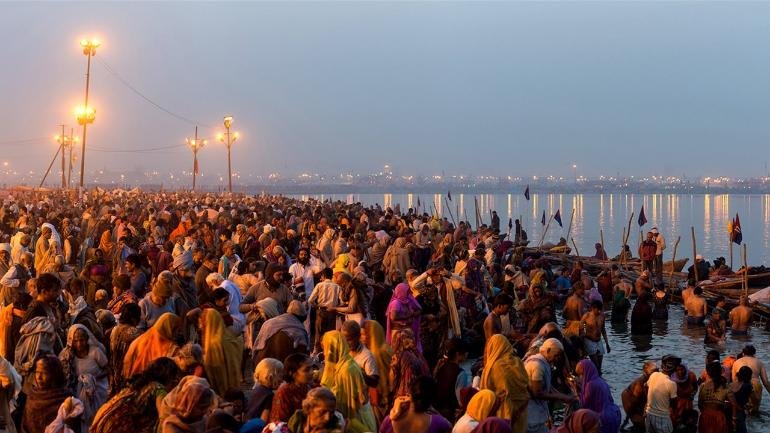The history of Kumbh Mela dates back to several hundred years ago. It is one of the most ancient traditions in India. And in this article, you will learn more about the divine aspect of the Kumbh Mela. You would also understand it’s origin, the meaning of Kumbh Mela and the greater purpose in life. You would also know when half or full kumb occur and understand the overall significance of Kumbh Mela.
Finding Its Roots – History of Kumbh Mela
The history of Kumbh Mela is even older than Lord Rama and Krishna. The roots of this ritual are deeply connecting to man’s inborn craving for happiness, prosperity, fame, good health, well-being, enlightenment and immortality. The Vedas, Puranas, and other texts are full of references to these facts. Saints and sadhus who have to reach the level of enlightenment tell us that most Puranic tales are there in the format of a code language. And it is through this language that one reveals the universal truths to the layman.
Tracing Back To A Tale – History of Kumbh Mela
One can even trace the history of Kumbh Mela back to one such tale, which associates with the Samudra Manthan or the churning of the ocean. One can describe this event as an alchemical process through which the first to emerge was poison. And Lord Shiva consumes this very poison. This was followed via mind-boggling divine attributes of health, wealth, beauty, power, auspiciousness and immortality. All of these in the form of nectar or amrit are those that surface from the sea.
What Is Samudra Manthan? And How Does It Act As The Origin Of Kumbh?
Often people consider Samudra Manthan as the source for the origin and history of Kumbh Mela. When Amrit rose from the ocean, Vishwakarma, the divine architect, was the one to create a magnificent Kumbh or pot to contain it. This Amrit Kumbh was the main attraction to all those who were present. A struggle of epic proportions ensues between the devas and asuras for the Amrit Kumbh. During the battle, one spills a few drops of Amrit at four different places, at four different times. Therefore, one celebrates the Kumbh Mela at those four places when the same zodiacal position repeats itself.
Jupiter, Saturn, Sun And Moon’s Role
The moon, the sun, Jupiter and Saturn all them made a team protect the Amrit Kumbh from the asuras. Let’s take a look at the planetary significance of Kumbh Mela:
- The moon helps in preventing the Amrit from spilling out
- The sun helps in protecting the Kumbh from either the event of splitting or breaking
- Jupiter prevents the asuras from snatching and fleeing with the Amrit Kumbh
- Saturn assists the sun in the form of instilling the fear of Indra (the king of the devas) in the minds of the asuras.
- The Agni tatwa or the fire element rules the sun or fire element, and the soma tatwa or water element rules the moon, together with control the activities of the entire universe.
The Flow of Energy – Significance of Kumbh Mela
The significance of Kumbh Mela can also be witnessed in the flow of energy. Well, one can sustain both the microcosm and macrocosm via Agni tatwa and Soma tatwa. The moon and the sun can sustain the entire metabolism, catabolism and anabolism. This is the thing that represents in the physical body as two very important nadis or flows of energy, i.e, the Pingala and the Ida.
These two nadis are essential not just for the physical and mental activities of man but even for his spiritual enlightenment. This clearly explains why, in the story of Samudra Manthan, the sun and the moon are shown as the foremost protectors of the Kumbh.
Half Kumbh And Full Kumbh
As per the story, the gods were the ones to carry the Amrit Kumbh. And during this time, some Amrit fell off from the Kumbh at Haridwar, Allahabad, Nashik and Ujjain. These planetary positions recur after a lapse of six years and twelve years. And this is when the ardha or half Kumbh and purna or full Kumbh are held. This is another significance of Kumbh Mela.
Four Places Of Kumbh Mela
In the history of Kumbh Mela, it has always been held at four places:
- Prayag, where the Ganga, Yamuna and Saraswati confluence. The Kumbh is held at Prayag, in Allahabad. And this is when Jupiter enters Aries, and the sun and moon enter Capricorn.
- Ujjain, where flows the river Shipra. It is held at Ujjain, in Madhya Pradesh, when Jupiter is in Leo and the sun in Aries.
- Nashik, where originates the river Godavari. In Nashik, in Maharashtra, the Kumbh is held when both Jupiter and the sun are in Leo.
- Haridwar, where the Ganga touches the plains when coming down from the mountains. In Haridwar, it is held, at the foothills of the Himalayas. This is when Jupiter is in Aquarius and the sun is in Aries.
Maha Kumbh
The Maha Kumbh is held every twelve years. This is an indication of the struggle between the divine beings and the demons for the Amrit Kumbh which lasts for about twelve days, which equals twelve human years. The nakshatra or the constellation determines the exact period of the Kumbh. It also decided the tithi or day as per the lunar calendar. And notes down the movement of planets to form special alliances.
According to the calculations of astrologers and astronomers, the exact position that the planets had held during the Samudra Manthan when the drops of amrita fell, occurs once in every twelve years. Lakhs of devotees take a dip in the waters of these rivers at the Kumbh Mela. Because during that period, a nexus of cosmic energies converge at that spot and charges the waters. This brings in a dramatic change in the destiny of the devotees which is divinely alchemist.








